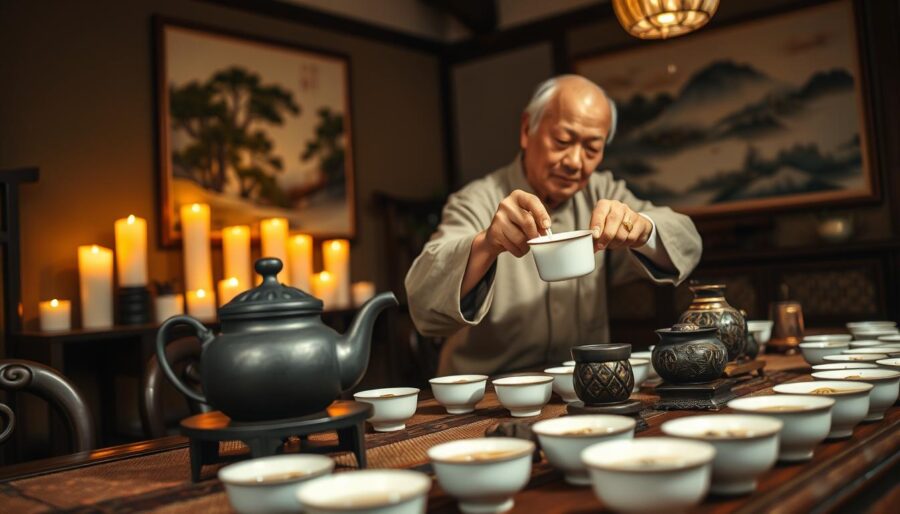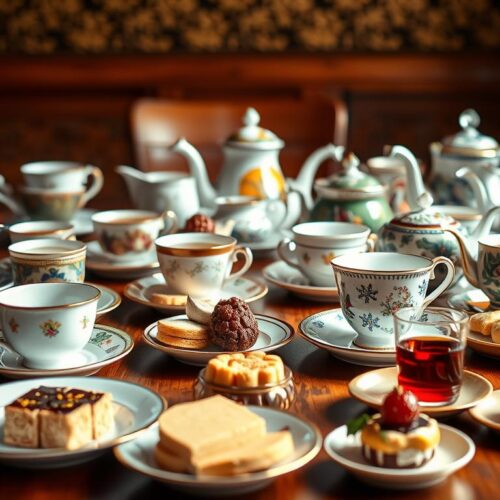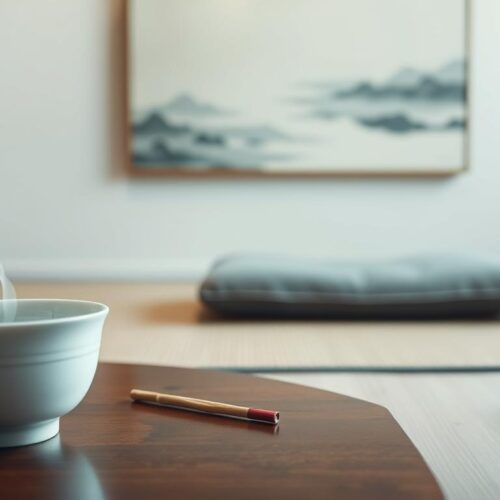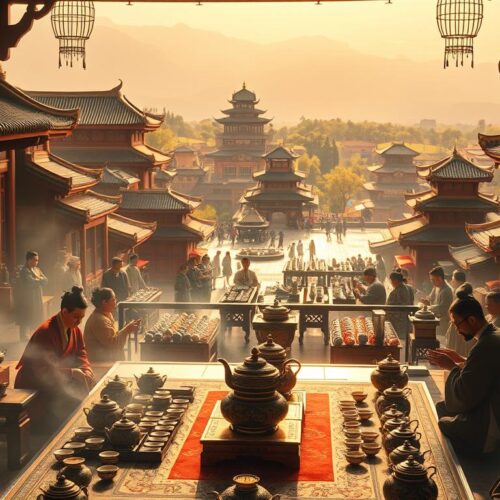Gongfu Cha means “making tea with skill.” It offers a special way to enjoy tea, different from how it’s done in the West. It came from ancient Chinese tea ceremony traditions. This method focuses on skill and being present in the moment. When preparing tea, it makes the experience better for those who love tea.
This practice started during the Song Dynasty. Since then, it has grown into a detailed ritual. Now, tea enthusiasts all over the world love it. Gongfu Cha is not just about the look of the tea. It’s also about the joyful taste and feel it brings.
Introduction to Chinese Tea Ceremony Traditions
Chinese tea ceremony traditions paint a beautiful picture of customs centered around tea enjoyment. Gongfu Cha is especially famous among them. It highlights the value of tea, respect for nature, and the joy of sharing tea with friends.
Gongfu Cha sets itself apart from Japanese tea traditions by embracing creativity and personal touch. This approach allows you to dive deep into tea’s varied scents and tastes. It also helps create a calm and mindful space.
Learning about the cultural roots of tea in these traditions lets you bond more deeply with the rituals and community. As you explore the intricacies of these ceremonies, your appreciation for tea artistry will deepen. This will enhance both your experience and your bond with the Gongfu Cha world.
Overview of Gongfu Cha Ritual
The Gongfu Cha ritual showcases the depth of tea culture in China. It focuses on careful preparation and the enjoyment of tea. Unlike Western methods that use large teabags, Gongfu Cha prefers smaller teapots or gaiwans. This method extracts rich flavors through several infusions.
This ritual turns preparing tea into an art. It promotes mindfulness and purpose. As people partake, they not only enjoy the taste but also bond socially. Each serving of tea fuels discussions and brings insights, deepening the collective experience. It highlights the tea’s unique tastes and aromas and underlines community’s value in Chinese tea culture.
Essential Teaware for Gongfu Cha
To really get into Gongfu Cha, you need the right teaware. You’ll want a Gaiwan, a fairness pitcher, strainers, and aroma cups. Each one has its own job and makes the tea taste better.
The Gaiwan is a brewing pot made of porcelain with three parts. It’s good because you can see the tea leaves and it’s easy to use. Tea lovers like it a lot. The Yixing teapot is also great, made from special clay. It keeps the taste of the tea, so each cup gets better.
Choosing the right tools for Gongfu Cha is important. Look for good materials and design. A fairness pitcher spreads out the tea evenly. Strainers keep leaves out of your drink. Aroma cups help you smell the tea’s fragrance. Together, they make your Gongfu Cha experience amazing by highlighting your tea’s unique taste.
Preparing for the Ceremony
Getting ready for a tea ceremony is key to a memorable Gongfu Cha. An inviting space for tea is crucial. This can be a special tea table at home or a cozy spot that allows for easy relaxation and engagement. It’s important that all your teaware is clean, showing your commitment to the ritual. A tidy space without distractions focuses attention on the tea.
In setting up for Gongfu Cha, think about how you present the tea leaves. Showcasing them with a tea scoop makes the table look good and delights the senses. Guests often wash their hands to show respect and get ready for the tea’s scents. These steps make the tea ceremony feel special and uplift the whole experience.
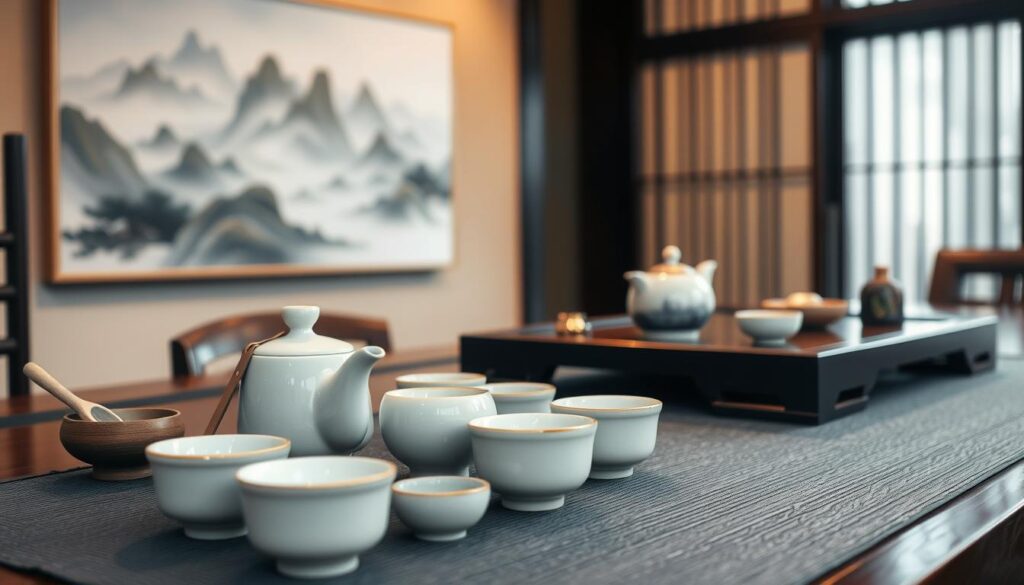
Steps of the Gongfu Cha Process
The Gongfu Cha process makes tea with great care to bring out a rich flavor. It follows steps that highlight the tea’s natural taste.
First, warm your teaware to get consistent brewing. Pour boiling water into your teapot and cup. Let them sit for a bit. Then, add the right amount of tea leaves. Usually, use one gram of tea for every 15 ml of water.
Before steeping, rinse the leaves with hot water. This wakes up the tea’s aroma and cleans off dust. When steeping, keep it short, from 5 to 30 seconds. Use cooler water, around 170°F, for gentle teas and hotter, near 200°F, for stronger types.
After steeping, pour the tea into a fairness pitcher. This makes sure the flavor is the same in all cups. This part of the Gongfu Cha encourages everyone to enjoy the tea’s full taste. Thanks to this method, you get a deep understanding of the tea’s many flavors and scents.
Tea Tasting in Gongfu Cha
Trying tea within the Gongfu Cha method makes the experience better. It lets you enjoy the tea with all your senses. Start by looking at the leaves closely. Notice their shape, color, and how they feel. These details help you know more about the tea’s quality and flavor.
The next step is smelling the tea to understand its complex flavors. When you brew the tea, breathe in deeply to catch all the different scents. These smells give clues about how the tea will taste, making the experience richer.
As you drink the tea, taste the different notes with each infusion. Each time you steep the tea, it reveals new flavors, showing how it changes. Look at the dry and wet leaves and think about the aftertaste. Each part tells you something about the tea’s journey.
This careful way of tasting tea stresses being mindful. Take your time to notice how the flavors change, so you can truly understand the tea. The Gongfu Cha ceremony is not just about tasting great tea. It also brings you closer to the world of tea.
| Infusion Number | Flavor Notes | Aroma Characteristics | Aftertaste |
|---|---|---|---|
| 1 | Floral, light sweetness | Delicate, fresh | Lingering floral hints |
| 2 | Vegetal, grassy | Herbaceous, bright | Clean, crisp |
| 3 | Rich, creamy | Warm, soothing | Soft, milky finish |
The Role of the Host in the Ceremony
The Gongfu Cha host is the heart of the tea ceremony. They lead guests, making sure tradition and respect are followed. As the facilitator, they carefully pour tea for everyone. They also make sure each guest’s preferences are met.
While serving, the host talks about the tea. They share where it comes from, its benefits, and its flavor. This makes the tasting richer and connects guests to the ceremony. A good host makes a space where everyone can be creative and have fun. This lets everyone deeply enjoy this ancient practice.
| Tea Ceremony Roles | Responsibilities | Skills Needed |
|---|---|---|
| Gongfu Cha Host | Pouring tea, guiding the ceremony, sharing insights | Interpersonal skills, knowledge of tea |
| Guests | Appreciating the tea, engaging in conversation | Open-mindedness, communication skills |
Traditional Variations of Tea Ceremonies
China’s traditional tea ceremonies show a rich variety of regional practices and flavors. Each area has its own way of doing things. For example, Gongfu Cha from the Chaozhou region focuses on a detailed, hands-on tea brewing method. This style combines art and precision, making each sip better.
Different areas might be formal or relaxed, depending on the occasion. Fujian’s ceremonies use oolong tea to highlight their local favorite. Zhejiang’s ceremonies, however, celebrate green tea. Each traditional tea ceremony shares its own story and local tastes. This gives us a peek into the culture behind these practices.
Learning about these regional differences makes us appreciate Gongfu Cha and China’s tea culture more. Every ceremony is more than just a ritual. It’s a way to connect with the area’s history and spirit.

| Region | Tea Type | Style | Cultural Significance |
|---|---|---|---|
| Chaozhou | Oolong | Gongfu Cha | Focus on artistry and precision |
| Fujian | Oolong | Formal | Showcase local specialties |
| Zhejiang | Green Tea | Casual | Casual gatherings and social connection |
Mindfulness and Meditation in Gongfu Cha
Gongfu Cha is more than just making tea. It’s a deep practice of being mindful during tea time. You must pay full attention to every part of the ceremony. This helps you slow down and really focus.
The smooth actions, warm teaware, and the tea’s scent are key to your experience. They keep you living in the now.
Many people see Gongfu Cha as a special way to meditate. Each pour and sip help clear the mind. This process builds a strong bond with yourself, the tea, and everything around you. By doing this ceremony, you grow more aware, relaxed, and calm.
Bringing mindfulness and meditation into Gongfu Cha offers many perks:
- Enhanced focus and concentration
- Reduction of stress and anxiety
- Increased appreciation of tea’s flavors and aromas
- Promotion of overall well-being
With mindful tea practices, you start a journey that improves your mind and soul.
Importance of Seasonal Ingredients
The art of Gongfu Cha gets better with fresh, seasonal tea leaves. Using leaves that match the season boosts both taste and smell. This makes drinking tea a lively pleasure. High-quality leaves, picked at the right time, show off special traits from their surroundings and when they were picked.
Choosing seasonal ingredients connects you more with nature. Every season changes the tea’s character and how it should be brewed. By using fresh ingredients, you start to notice the subtle taste differences with each new batch.
Seasonal habits make Gongfu Cha richer, leading to a thoughtful experience with every sip. Engaging with fresh ingredients helps you understand nature’s rhythms. This creates a closer bond with the tea you enjoy.
Contemporary Adaptations of Chinese Tea Traditions
In recent years, modern tea culture has changed the way we practice Gongfu Cha and other Chinese tea rites. These changes blend old rituals with new styles, making it fun for tea lovers to keep tradition alive in fresh ways. Now, specialty tea shops bring fine teas to everyone, breaking down borders in tea exploration.
Today’s tea ceremonies mix global touches, introducing flavors and customs from across the world. For example, some tea masters blend Eastern and Western ways of tea drinking. This creates a new, mixed style that attracts more people. By modernizing traditions, you get to enjoy the depth of Gongfu Cha with a contemporary twist.
The tea community is growing strong, with creativity leading the way. You’ll see more casual tea meet-ups, where there’s less focus on strict rules. This makes the tea culture more approachable. It honors our tea roots while welcoming those new to the scene.
| Aspect | Traditional Gongfu Cha | Modern Adaptations |
|---|---|---|
| Setting | Formal tea houses | Casual home gatherings |
| Teaware | Classic Yixing teapots | Variety of modern designs |
| Flavors | Traditional Chinese teas | Infused blends with global flavors |
| Approach | Strict adherence to ritual | Flexible, creative interpretation |
As you dive into this blend of old and new, take a moment to value how these changes link tea lovers globally. Embracing new practices doesn’t just keep Gongfu Cha’s spirit alive. It also makes your tea journey richer in our fast-paced world.
Conclusion: Embracing the Art of Gongfu Cha
Embracing Gongfu Cha takes you on a journey into Chinese tea ceremony traditions. Through this ritual, you learn not just Gongfu Cha but also the delicate art of tea prep and tasting. Each step uncovers new flavors and wisdom, enhancing your tea experience and knowledge.
Gongfu Cha is beautiful because of its detailed steps, making you enjoy each moment. This practice connects you with the tea, the tools, and your surroundings. It also invites friends and family to explore teas together, boosting your appreciation for tea.
As you dive deeper into Gongfu Cha, your bond with tea grows, bringing mindfulness and reflection. This tradition isn’t just about tea; it’s about making connections, understanding culture, and adding calm to your day. So, grab a cup of tea and let Gongfu Cha bring peace and joy into your life.

